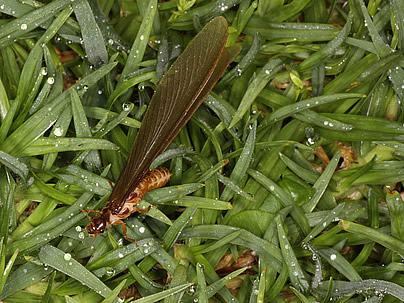Termites are social insects from the order Isoptera, living in colonies of thousands and often associated with decomposing dead wood. They form a colony divided into castes, comprising thousands of sterile workers and soldiers, and a king and queen whose role is solely reproductive. This article discusses grass termites, particularly from the genera Syntermes and Neocapritermes, which are primarily responsible for causing circular patches and yellow spots in lawns and for the death and weakening of garden plants, such as ground covers and shrubs.
These termites typically feed on the roots and leaves of lawns and can usually be seen early in the morning during their foraging activities. For the rest of the day, they take refuge in underground galleries beneath the grass. There is no way to prevent lawn contamination unless your garden is in a closed greenhouse. Termites spread through flights, where pairs form and reach the farthest areas of your garden to start a new colony.
Feeding on the roots, rhizomes, stolons, and leaves of lawns, termites quickly weaken them, as the plants become deficient in absorbing water and nutrients from the soil. The result is unsightly and sparse lawns with patches and circular areas. Almost all species of ornamental grasses can be affected by these termites, such as São Carlos grass (Axonopus compressus), Emerald grass (Zoysia japonica), Korean grass (Zoysia tenuifolia), St. Augustine grass (Stenotaphrum secundatum), Bluegrass (Poa pratensis), Batatais grass (Paspalum notatum), etc. These termites originate from regions naturally covered by grasses, such as savannahs, prairies, typically with poorer and drier soil.
This gives a clue on how to prevent and assist in their control, namely, maintaining healthy and balanced soil, with added organic matter and supplemental irrigation if necessary. However, one should avoid adding dead mulches such as sawdust, wood shavings, pine bark, coconut husk, or wood chips. In this case, peat and topsoil or organic compost are better options, despite degrading more quickly. The use of inert materials like artificial husks and vermiculite is also a good option.
In cases of intense infestation, it may be necessary to treat the lawn with insecticidal agrochemicals. The most common active ingredients in these products are fipronil and malathion. These products are toxic and require the use of equipment and specialized professionals. Before taking any action, consult an agronomist. They will make the correct diagnosis of the problem and can guide you to the most appropriate treatment. Not all circular patches and yellow spots are caused by termites. Your lawn could be affected by mole crickets, or simply by dog urine.
Great care and responsibility are needed when treating a termite-infested lawn with insecticides. Often, the lawn will need to be closed off, preventing access by people and pets who could be contaminated by the poison. Other aspects to consider are potential contamination of the groundwater, if it is shallow, and the migration of various insects to neighboring buildings, such as spiders.
The insecticides used are not specific to termites, therefore causing a significant ecological imbalance in the garden, killing beneficial insects as well. For this reason, never apply near or on flowers, to avoid killing bees and butterflies. It is important to apply in directed jets, only to affected areas, preferably using marker dyes, and avoiding windy days. The goal here is insect control, not total annihilation.
Unfortunately, there are few commercially viable biological control options currently available. However, research indicates that fungi, ants, and nematodes can effectively control this type of termite. The fungus Metarhizium anisopliae can be found commercially in the form of baits in cellulose material suitable for termites, such as paper, but its efficiency in controlling lawn termites is not well known. Natural products with insect repellent extracts, based on plants like neem, basil, tobacco, garlic, onion, pepper, lavender, vetiver, etc., can also be used.


